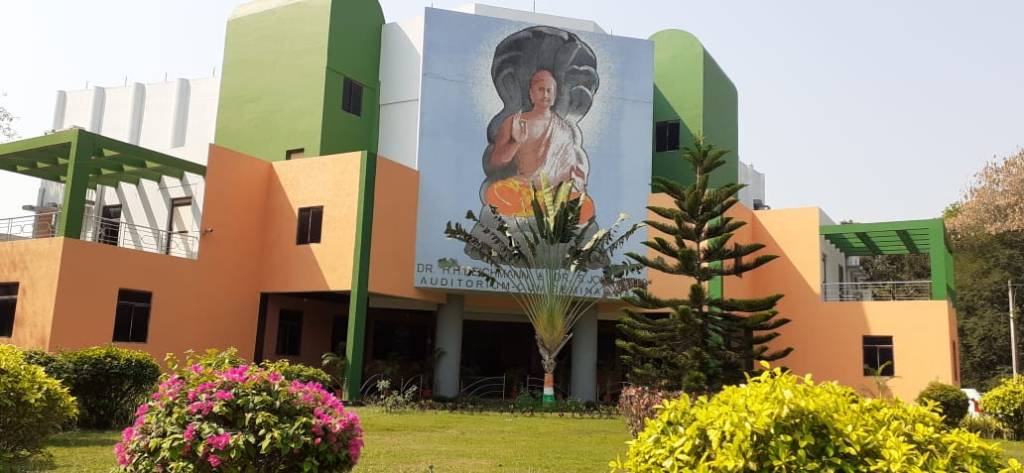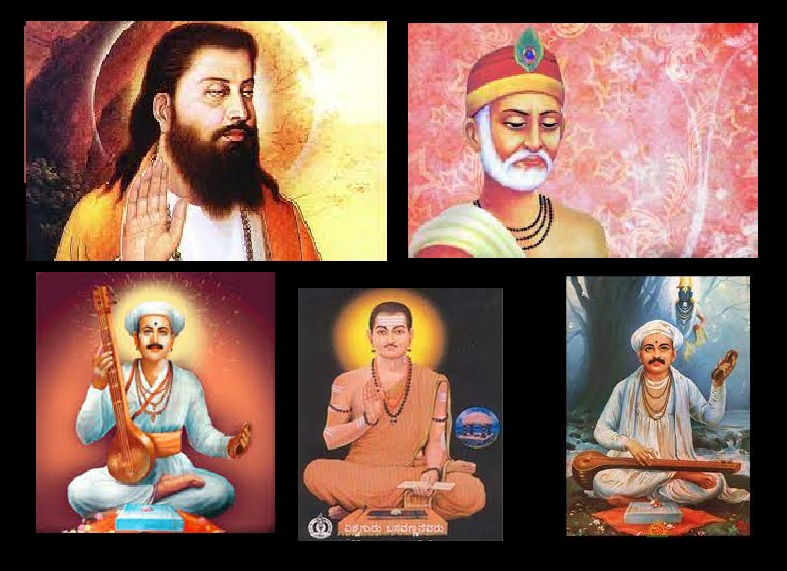The proceedings of the National seminar Buddhism and Sectarian Religious faith in India or Buddha and Anti-caste Bhakti Saints held at Acharya Nagarjuna University on March 1st and 2nd 2023 (1)

Started on February 28th and reaching Vijayawada on March 1st, 2023: The National seminar on “Buddhism and Sectarian Religious faith in India,” was conducted at the Acharya Nagarjuna University on March 1 and 2, 2023. Many papers were presented by the academicians delving upon the subject matter mainly interpreting that Buddha or Buddhism was responsible for the creation of anti-Bakti movement. Though, I have come to the ANU for many times to attend the seminars and conferences for presenting papers, now I am visiting here after five years, for various reasons. January 2023, I might have come, but, my paper was not accepted on last minute[1]. Anyway, now I received a mail that my paper had been accepted. So I started preparing to come. As usual my friend Dr Madhusudhana Rao also prepared to come, but, suddenly he was not feeling well because health problem and he had to stay back. With much difficulty, I started travelling towards Vijayawada on 28th February 2023. Now, as I am a Guest Faculty, I had to apply for leave and attend the seminar. Unusually, the Pinakini Express was late and I could reach Vijayawada by 11.50 PM instead of 9.20 PM. When I reached the Guest House of the ANU, it was 12.40 PM and I had to write March 1, 2023, as the next day started. The following paragraphs contain details that are reproduced from the brochure issued for the seminar.

The Centre for Mahayana Buddhist Studies[2]: The seminar was held under the auspices of The Centre for Mahayana Buddhist Studies. It was established in 1982 under the scholarly guidance of Padma Vibhushan Prof. K. Satchidananda Murthy, the inspiration of late Prof. R. Subrahmanyam, who extensively excavated the Nagarjunakonda site in 1960 and the then External Affairs Minister Dr. P.V. Narasimha Rao. His Majesty the King of Bhutan, Jigme Singye Wangchuk inaugurated the Chair of Mahayana Buddhism and donated an endowment fund. The UGC grant had provision for constructing a Chaitya model building to house the Centre. Padma Vibhushan Prof. K. Satehidananda Murthy is the Honorary Director of the Centre. Teaching Programme: In accordance with the guidelines provided for the Centre by the National Committee of Experts, the Centre lays focus on the multidimensional study of Buddhism in general and Mahayana Buddhism in particular. In 1993, Master degree in Philosophy with emphasis on Buddhism was started. I find many Buddhist students from Myanmar and other countries are studying there.

About Acharya Nagarjuna University: The Name, Acharya Nagarjuna University, is quite significant in that the greatest Buddhist preceptor and philosopher Acharya Nagarjuna founded a University on the banks of river Krishna some centuries ago, and made it great of centre learning, attracting a large number of teachers and students from distant parts of the world[3]. The present Acharya Nagarjuna University is not very far from the hallowed spot, as it derives its moral and intellectual sustenance from Acharya Nagarjuna. In 1967, Andhra University started a Post-graduate centre in Nallapadu, Guntur District, Andhra Pradesh, as an Extension Centre to cater to the needs of higher education of the people of this region. It is in the fitness of things that a university should grow from this Centre to fulfill the desire of the people of this belt. Accordingly, Nagarjuna University came into being in August 1976. Acharya Nagarjuna University since then has grown into a large University with 37 Academic Departments. Its jurisdictions was extended to two districts now having over 400 affiliated colleges offering Under-Graduate, Post- Graduate, Engineering, Education, Law, Pharmacy and Oriental Languages courses. Now it has 55 Post-graduate teaching — cum — research courses on the campus, while around 70 affiliated colleges offer P.G. Courses. The theme of the seminar is explained as follows:

The non-Vedic Sramanic tradition[4]: The contemporary interest in Buddhism is based on its social appeal. Within India Buddhism has appeared as an alternative to the hierarchical and in egalitarian ideology and Hinduism. Buddhism is viewed as a system which was more sympathetic to oppressed groups and social solution to the problem of caste oppression. After a pioneering work of Dr. Ambedkar on the social philosophy of Buddha some scholars like Eleanor Zelliot (1992), Uma Chakravarthi (1996), Rhys Davids (1997), Gail Omvedl (2003) and others worked on the social dimensions of Buddhism. With the social revolution of Buddhism, an alternative culture to the Vedic or Brahmanical culture also evolved in all parts of India. Buddha emerged from the non-Vedic Sramanic tradition and opposed the superstitious belief system and encouraged scientific enquiry.

Medieval Virasaivam and its impact: Though Buddhism was defeated and erased physically from its birth place, it is surviving in several forms of faiths and cults. Buddhist thought has been perpetuating in the form of local religious Traditions and customs. The rise of different sectarian religious movements during the medieval and late medieval periods in India carried forwarded the anti-caste and non-Vedic philosophical notions of Buddha. Those sectarian leaders rejected Vedic Brahmanism and propagated egalitarian ideas within the framework of the religion. Siddha Tradition in South India was evolved out of Buddhist school of Vajrayana was more prevalent among the lower strata, strived to attain equality in religious sphere. Many Siddha cult centres of present Andhra and Telangana states including Siddhavatam, Siddeswaram, Siddula Guttalu etc. are the live examples for this phenomenon. The medieval text (14-15th CE) in couplet form ‘Navanadha Charitra’ written by Gourana also mentioned about the Siddhas.

The followers of Virasaivam: Virasaivism advocated the notion of equality among all human beings irrespective of caste, creed and gender. Basaveswara, the chief profounder of Virasaiva religious movements is known for his social reforms. Palkuriki Somandha, the Saivate poet also reflected Virasaiva anti- caste philosophy through his works including ‘Panditaradhya Charitra’ and ‘Basavapuranam’. Akkamahadevi, a woman saint and radical challenged all sorts of hegemony including patriarchy has been emerged out of this sectarian movement. A peculiar community by name Jangama among different lower castes has been emerged from the followers of Virasaivism.

How Virasaivam paved way for the upliftment of lower-caste people: Similarly, Vaishnavism also propagated social equality during the medieval period. Ramanuja had admitted lower castes into his Vaishnava fold and mentored them as Maladasu and Madigadasu. Dasari community has been emerged among the lower castes as one of the influential inter sub-caste, maintained some sort of high rank as priestly class within lhe same group. Brahmanaidu, a medieval social reformer and staunch follower of Vaishnava cult has organized inter-dinning among different communities and gave priority to Mala Kannamadasu, the army commander from lower community. Evolution of Chennakesava cult among the lower castes witnesses for this phenomenon. It s interesting to note that the priests of the Chennakesava temples were appointed from the Mala community.

Non-Brahmin Bakti saints: Saint Ravidas, Kabir, Chokkameta, Bhima Boi and others form North India also framed anti caste and non-Brahmin philosophy. A woman saint Meerabai and her Bhakti also considered to be an anti-hegemonic philosophy. Similarly there are many social reformers in Telugu speaking regions. Philosophers from Sudra communities such as Pothuluri Virabrahmam, Yogi Vemana and others revolted against the hypocrisy of Brahmanism in Andhra. There are many spiritual leaders at local level including Nasarayya, Dunna Iddasu, Yadla Ramadasu and others rejected the Vedic Brahmanism and promoted spiritual democracy. There are Sufi saints emerged from Muslim background also propagated equality among all sections of the society. Dargas are the centres acted for social harmony, integrated all communities and strived for the unity among Hindu and Muslim groups.
© K. V. Ramakrishna Rao
05-03-2023

[1] Earlier, I used to get the circular by post and based on that paper preparation used to get started. After submitting and getting confirmed about presentation, tickets would be booked and journey planned. Nowadays, the information about the seminar is sent only to the selected friends. It is posted in the social media one day earlier or on the same day, thereby virtually stopping others, particularly, even willing persons from other states cannot come. Actually, nowadays, I do not understand what has started taking place or going on in conducting seminars or conferences, though, I have been attending more than 650 in the last 40 years different parts of India. May be some sort of “politics,” personal likes-dislikes and such other factors may have started playing role.
[2] Based on the ANU website – https://www.nagarjunauniversity.ac.in/deptdet.php?id=1023
[3] Based on the ANU website- Acharya Ngarjuna University- A profile – https://nagarjunauniversity.ac.in/profile.php; more details – history, location, emblem etc., can be read from website.
[4] A śramaṇa (Sanskrit: श्रमण, or samaṇa (Pali: 𑀲𑀫𑀡; Chinese: 沙門 or 沙门, shāmén) means “one who labours, toils, or exerts themselves for some higher or religious purpose” or “seeker, one who performs acts of austerity, ascetic”. During its development, the term came to refer to several non-Brahmanical ascetic religions parallel to but separate from the Vedic religion. The Śramaṇa tradition includes primarily Jainism, Buddhism, and others such as the Ājīvika. The śramaṇa religions became popular in the same circles of mendicants from greater Magadha that led to the development of spiritual practices, as well as the popular concepts in all major Indian religions such as saṃsāra (the cycle of birth and death) and moksha (liberation from that cycle).The Śramaṇic traditions have a diverse range of beliefs, ranging from accepting or denying the concept of soul, fatalism to free will, idealization of extreme asceticism to that of family life, renunciation, strict ahimsa (non-violence) and vegetarianism to permissibility of violence and meat-eating.
Filed under: academic, academicia, Acharya, Acharya Nagarjuna University, adi sankara, agnostic, agony, ambedkar, ambedkar idea, ambedkar ideology, ambedkar philosophy, anthropology, anti-brahman, anti-brahmin, anti-caste, anti-hindu, anti-indian, archaeological remains, archaeological sites, archaeology, Aryan, ascetic, atheistic, atma, besanagar, Bhagawat Gita, bhagawatgita, brahman, brahmin, buddha, Buddhist, buddhist claim, Buddhist relic, buddhist site, caste, chronology, civilization, colonial, Colonialist discourse, colony, colour, controversy, culture, dalit, dalit buddhhist, dalit Buddhist, dalit christian, dalit hindu, dalit Jain, dalit literature, dalit muslim, demolition, demonstration, demythologization, depressed class, desecration, dharma chakra, dharmachakra, Digambara, discrimination, DNA, Dramila, Dravida, Dravidam, dravidar, Dravidi, Dravidian, Dvaita, elixir, ethnicity, ethnology, female infanticide, female-worker, feminist, gender, goddess, himsa, Hindu, Hindu religion, hindu ritual, Hinduism, historicity, historiography, historiosophy, history, inculturation, jain, jain persecution, jainism, jains persecuted, linguistics, linguistuic study, literatures, marxism, Marxist historian, Marxist-Leninist, myanmar, nationalism, neolithic, sectarian, sectarian faith, sectarianism, woman, women | Tagged: Acharya Nagarjuna University, anti-caste, bakti, bhakti, bhakti movement, buddhism, caste, caste politics, casteism, Digambara, Dramila, dravid, Dravida, Dravidam, Dravidar, Dravidi, Dravidian, dravidian model, dravidian race, dravidian stock, hinayana, Hindu religion, Hinduism, jain, Jaina, jainism, jainisn, mahayana, Nagarjuna, nagarjuna sagar, praccana buddha, rishi, saint, scheduled caste, Swetambara, theravada, train, vijayawada | Leave a comment »

